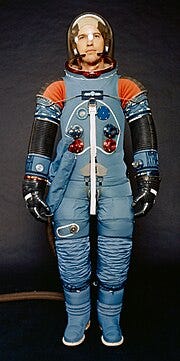NASA adapted the G3C for use on the first planned Apollo missions. The suit was designated the A1C. It added new connections for power and air, and the parachute used in Gemini was replaced by a life vest. The A1C never flew, and after the Apollo 1 fire, was replaced with the A7L.
The A7L was a new design, which was worn during launch and re-entry, as well as on spacewalks and on the lunar surface.
The suits were made of five layers with rubber joints. The sixth layer, on top, was white and made of fireproof materials. Connections at the neck and wrists allowed the astronauts to attach the gloves and the helmet quickly. NASA adopted the fishbowl helmet, giving the astronauts an unrestricted view. The black rubber gloves used inside the spacecraft were custom molded to give the crew additional flexibility. Boots were built into the suit. Life support came from the spacecraft via umbilical hoses. This basic configuration weighed 62 pounds and was worn only for launch and reentry. There was a zipper that allowed the astronauts to get out of the suits after launch. It started at the back of the helmet connection, went down the back and around the groin.
Beneath the suit, the astronauts wore the Constant Wear Garment (CWG), which amounted to a heavy-duty suit of long underwear that covered everything except the head and hands. It had fly openings in the front and the back for waste elimination. Fasteners allowed the attachment of the biomedical sensor belt. It was designed to be worn for six to seven days before being replaced by a second set packed into a locker. During launch and reentry, the crew would wear the Urine Collection and Transfer Assembly, which amounted to a rubber condom with a tube leading to a collection bag.
After launch, the astronauts would wriggle out of the A7L and wear a set of Inflight Cover Garments over the Constant Wear Garment. This lightweight suit was either white, light blue, or mustard colored. It consisted of four pieces made of flame-resistant beta cloth. The long-sleeve jacket had holes for the medical sensor connectors and was snapped closed at the wrists and down the front. The pants had snaps for the waist and at the ankles for the boots.
During the mission, the crew wore the famous brown and white ‘Snoopy caps.’ Officially called the Communications Carrier Assembly, the caps were worn with or without the helmet and held the headset and microphone, which could be connected directly to the suit.
Getting into the A7L wasn’t easy. The astronauts would have to climb in from the back and wriggle their hips and shoulders to get the suit on. The cooling garment and the belt sensors would then be plugged into the inside of the suit. At that point, the zipper would be pulled up with the help of a ribbon. Add the Snoopy cap, gloves, and the helmet and an astronaut was ready to go.
For lunar missions, there were several additions to the A7L for the Commander and the Lunar Module Pilot. The Constant Wear Garment (CWG) was replaced by a set of heavy-duty underwear known as the Fecal Collection System (FCS) and the urine collection and transfer assembly. Over that came the Liquid Cooling Garment (LCG), a nylon suit that looked like long underwear woven with plastic tubes that circulated water. The biomedical sensor belt was attached over the LCG. An outer shell was used on the helmet to decrease light reflection and provide better thermal control. It also had a gold sunshade visor. A heavier glove was provided. It was wrapped in a metal fabric to protect against punctures. The fingertips were silicone to add a little sensitivity. An overshoe that slipped right over the A7L boot was used to provide extra protection against puncture. The soles were made of silicone, giving the astronauts more traction and additional insulation. Beginning with Apollo 13, red stripes were added to the Commander’s suit so that Mission Control could easily identify him.
Life support on the moon was provided by the Portable Life Support System (PLSS). This backpack supplied power, oxygen, scrubbed out carbon dioxide, and regulated the temperature and humidity inside the suit. With all of the extras, the full A7L suit worn on the moon weighed 200 pounds. But in the moon’s gravity, it felt like only 33 pounds and the astronauts were able to move about easily.
When the Command Module Pilot needed to wear the A7L for spacewalks, he would add the three-layer Intravehicular Cover Layer (ICL) and could rely on the life support umbilical hoses instead of using the PLSS.
For the later, longer Apollo missions, the suit evolved into the A7LB. This design included new joints at the waist to allow astronauts to sit in the Lunar Rover. New joints were added to the neck as well, to increase the range of motion. The PLSS was modified to supply the additional oxygen, power, and water needed for the longer EVAs.
The Apollo spacesuits were custom fit for the individual astronauts. The prime crew of a mission required three — one for flight, one for training, and a backup just in case. The backup crew would have one suit for flight and one for training.




